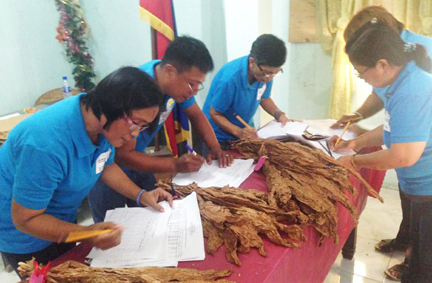News Articles
Tobacco leaf grading simplified with harmonization of leaf grades
 |
| Extension workers during a practicum on leaf grading |
THE National Tobacco Administration (NTA) has simplified the grading system with the implementation this year of the NTA Harmonized Grades of Locally Grown Virginia and Burley Leaf Tobacco.
The harmonization of leaf grades is contained in Memorandum Circular No. 001, series of 2018 signed by NTA Administrator Robert L. Seares on February 20 this year. The said Circular, which took effect beginning trading season 2018, covers the adoption of the Harmonized Grading and Classification System by all registered tobacco buying stations and field canvassers.
Dr. Roberto R. Bonoan, manager of the Industrial Research Department that spearheaded the harmonization of leaf grades, said that buying station operators and the NTA technicians assigned therein should adhere to these standards. Farmers, through their cluster leaders, were given advice regarding the new grading standards long before the start of the trading operations late last year.
Bonoan added that the harmonization of leaf grades helps eliminate confusion on the different grading systems/classifications of the buying stations and misunderstanding between farmers and sellers in grading the quality of leaves.
The agency had acknowledged that grading is the most disputed and very critical aspect of trading, as it determines whether the farmer gains or loses.
Before the harmonization, the farmers had been claiming that their tobacco leaves were not being given the appropriate grade, that some are graded arbitrarily, and that the buying stations show them a grading system/classification different from those of the NTA.
NTA Grading System
As provided by law, the Philippine tobacco industry adopted a leaf grading system, that is more physical-oriented and consists of only a few grades that can be easily followed by the local farmers.
Per NTA Grade Description of Philippine Virginia Leaf Tobacco, approved by the NTA Governing Board under Board Resolution No. 011-2000 on February 15, 2000, the leaf is given the topmost Grade "AA" if it has deep color of lemon or orange, rich in oil, thin and more than 10% allowance on injury; followed by A, B, C, D, E, F1, F2, R (reject). For Burley the topmost grade is A, followed by B, C, D, E, F, then R.
This is oversimplified compared with the grading system being used by the world traders since 2002, which runs to about a hundred or more, as this reflects the specific quality requirements deemed essential by the manufacturers.
Major leaf buying firms, such as PMFTC, ULPI, TMI and ConLeaf, use their own international standards, based on the demand in the international market, where leaves are classified according to stalk positions. These grade classifications, however, have caused a negative reaction from the farmers.
According to Bonoan, while the grade classifications are many, with each one being descriptive of the specific quality, a particular tobacco production technology or culture will produce only a few grades in the classification.
The idea to harmonize leaf grades in the country came after Lina A. Cera, Chief Science Research Specialist, and head of the IRD's Quality Assurance Division (QAD), and Alfonso E. Sabado, Supervising Science Research Specialist of QAD, attended in 2008 the USA Tobacco Visitors Information Course in North Carolina where they learned the principles and application of the U.S. Standard Leaf Grades for Flue-cured and Burley tobacco (U.S. and foreign grown).
After the training, the QAD team started characterizing locally grown Virginia and Burley tobacco using U.S. Grade Standards, from 2008 to 2011, but according to Cera, not all grades therein are for local applications. In 2012, the team started working on the harmonization of the grades being used by the U.S.A. and the system adopted by the world traders.
Need to harmonize
Cera explained that different buyer firms use different specifications but they refer to the same grade. These different grading systems have left tobacco farmers, including extension workers, confused.
For example, for Choice Quality Orange Leaf (B1O), only USA and TMI adopted this grade name. ULPI and PMFTC use First Quality Orange Leaf for the same grade name (in one instance ULPI used Good Quality Orange while PMFTC used Top Quality Orange Leaf). On maturity of leaf, USA, TMI, ULPI and PMFTC use "Ripe." In one instance, however, ULPI used "Mature to ripe" while PMFTC used "Very ripe." For the body of leaf, USA and PMFTC use "Fleshy."
TMI and PMFTC, in one instance, use "Medium" referring to the body, while ULPI has no specifications for this. Except for ULPI and PMFTC, all buyer firms use "Firm" to refer to the leaf structure. For oil, TMI and USA use "Rich in oil"; "Oily" for PMFTC; and no specifications for ULPI.
For color, all use "Orange" except PMFTC in one instance where it used "Light orange to orange." All firms use "Deep" to describe intensity, except ULPI which has no specifications for this. To describe width, only USA and PMFTC use "Spready" and the rest of the firms have no specifications for this.
Using the NTA harmonized standard, the specifications for the same grade name Choice Quality Orange Leaf (B1O) will just be ripe (maturity), fleshy (body), firm (leaf structure), orange (color), oily (oil), deep (intensity), and spready (width).
According to Cera, the elements of quality and the degree of words and phrases used in the specifications in the proposed NTA harmonized grades of locally grown Virginia leaf tobacco are almost synonymous in meaning, yet, they are sufficiently different to represent steps within the range of the elements of quality to which they are applied.
The conventional type of classification will still be retained for floor pricing. Using the above example, the grade name Choice Quality Orange Leaf (B1O) will be given the floor price for Grade "AA."
"That's why we have to harmonize or to bring different leaf grades into agreement for better implementation and easy understanding of users," Cera said.
Pilot-testing
A Technical Working Group, headed by Bonoan, with Cera and Sabado, branch managers and representatives from major leaf buying firms as members, was constituted in 2011. The group was tasked to come up with the first draft of the NTA harmonized grades.
The said draft was presented to the different tobacco buyer companies and also to the NTA Branch Managers for review and comments.
The draft of the NTA harmonized grades underwent four revisions through continuous consultations with the tobacco buyer companies.
Bobby F. Wellons, Division Training Instructor, Agricultural Marketing Service of Raleigh, North Carolina, USA, who was given a copy of the final draft during the Leaf Grading Seminar at Mighty Corporation office in Malolos, Bulacan in 2015, found the draft to be technically sound and in harmony with the principles of the internationally accepted leaf grading standards of Flue-cured and Burley tobacco.
Another big step forward in the harmonization was a pilot testing of the harmonized grades in selected buying stations.
According to Bonoan, the pilot testing helped the agency determine the harmonized grades of locally produced tobacco including the frequency and the economic advantage of using the harmonized grades over the grading system of private buying firms.
The draft of the proposed implementing rules and guidelines of harmonized grades was presented to the extension workers in 2015, with Cera and Sabado as resource persons. The output of the presentations became the basis for the holding of a training-seminar on leaf grading standards to a core-group of leaf grading trainers composed of the Tobacco Production and Regulation Officers of the Regulation Department and the different provincial branch offices, and the IRD research specialists. Farmer-leaders also participated in the said trainings.
According to Cera, the final draft of the Proposed NTA Harmonized Grades was presented to Administrator Seares, Deputy Administrator for Operations Atty. Mel John I. Verzosa, the managers from the different branch offices, and to the technical experts of the country's major leaf buyers. The leaf buyers presented their inputs to the draft in successive meetings in July last year.
Positive feedbacks
With harmonized leaf grades used in all trading centers in the country, Administrator Seares had expected a better grading system, as farmers tend to agree on things that they can really understand.
"In its first year of implementation, we have received good feedbacks from the farmers. Some of them are very thankful that now they can easily agree to grades given to their leaves, particularly on the quality, moisture, and sorting as to stalk position, thus avoiding unnecessary confrontation in the trading floor," said Administrator Seares.
Slowly, the tobacco farmers get to appreciate the importance of adopting the harmonized leaf grading system, following international grading standards, alongside the adoption of good agricultural practices, that lead to the production of tobacco leaves as required by the export market, thus making the harmonization endeavor worth the efforts to come up with the results that will redound to the benefit of all sectors of the industry.
The biggest challenge now for the agency is to build up the confidence and competence in the application of harmonized leaf grading standards. "Of course, this is subject to review every time production technology is improved, because we have to evaluate things, and in the long run, we may then limit or readjust the number of grades across all varieties," said Bonoan.
With the harmonized leaf grades, the agency officials are ensuring a profitable trading season for both the farmers and the traders. According to Bonoan, setting up a simplified grading system that follows the U.S. standards adopted worldwide will really make our tobacco competitive in the global market.
The trading season for tobacco has ended but the agency will continue enhancing its competence on international leaf grading standards using harmonized grades. (Neyo E. Valdez)






